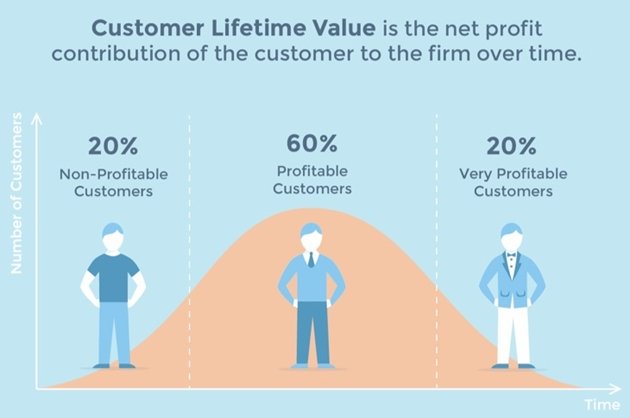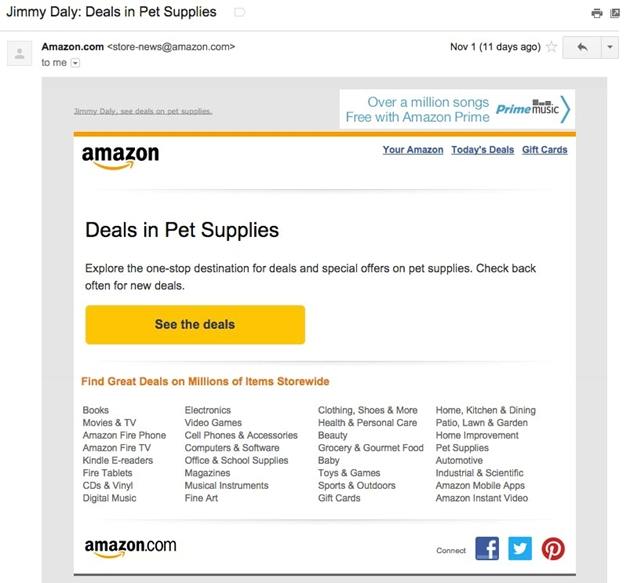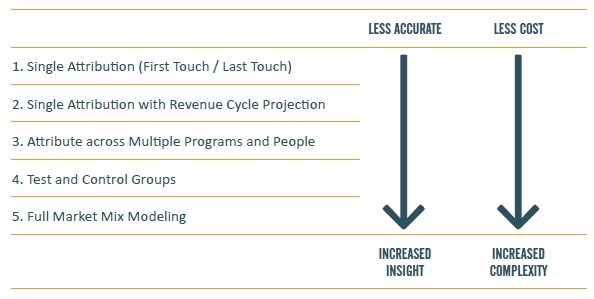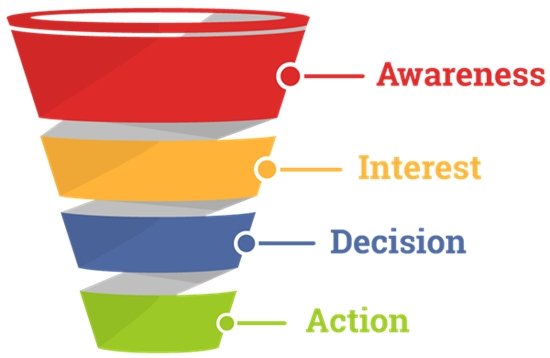Imagine you had a crystal ball that could predict the future. The view is murky, but there's enough to make an accurate forecast.
Having a marketing dashboard that measures vital KPIs is a bit like that crystal ball: It gives you enough insight to make better decisions to create a positive future by helping you generate traffic and leads and prove the ROI of your marketing activities.
In this article, I'll outline five key KPIs you must measure regularly. I'll show you how to measure them, followed by tips on how to improve the performance of each.
1. Customer Lifetime Value
Understanding the lifetime value of your customers is key. It informs many areas of your marketing, such as allocated budget and channels to focus on.
Customer lifetime value (CLV) is the projected revenue that your customer will generate for your business during that customer's relationship with you.
Let's say your customers spend anywhere between $54 and $118 when they buy with you, and the average transaction value (ATV) is $86.
Of course, not all customers spend the same. This image from Kissmetrics shows how uneven the distribution can be across different segments of customers, and it's something to bear in mind when attributing CLV to marketing channels:
 Source: Kissmetrics
Source: Kissmetrics
Then you must calculate the average purchase cycle (APC). You can do this across any timeframe, but we'll choose a year. In this example, purchase frequency is 1-7 per year, making the average purchase frequency four per year.
Finally, you must understand your customer lifespan (how long they remain a customer for). In our example, it's three years.
Now we calculate CLV using the following formula: (ATV x APC) x Lifespan = CLV
For our example above, that's ($86 x 4) x 3 = $1,032.
How to Improve CLV
You can optimize and increase CLV by focusing on only two areas: retention and upselling.
Having a customer loyalty system can increase your average purchase cycle and customer lifespan. This requires encouraging your customers to come back and purchase with you.
Email marketing and automation can help you do so. Send timely, relevant emails with exclusive offers to entice them back.
Personalization is key. There's no point in offering product to segments that find it irrelevant. Use a tool like Nosto to automate recommendations in this manner.
Amazon is the poster child for this level of personalization. Every part of the customer experience is tailored to the customer's tastes and interests:
 Source: Vero
Source: Vero
Use upselling techniques to increase your ATV. Are there add-ons you can offer to your product or service? You can also entice customers with complementary products before or during checkout.
2. Customer Acquisition Cost
Now you know what the average customer is worth, you can calculate how much you should spend to acquire them. Having this cost data is key to optimizing bottom line.
Calculating customer acquisition cost (CAC) is simple. Divide your total acquisition costs by the number of new customers generated over a specific amount of time.
As a marketing manager, your job is to ensure that CAC is lower than CLV. Ideally, you want a CLV-to-CAC ratio of 3:1. If you're in the 4:1 region, you're underinvesting; and if it's 1:1 or higher (e.g., 2:1) means no growth or negative growth.
When calculating CAC, keep various factors in mind:
- Costs associated with all marketing campaigns
- Salary of Marketing and Sales employees
- Sales and marketing software that assist with growth
- Professional services or outside contractors hired
- Other related costs associated with marketing
How to Improve CAC
The traffic you generate from marketing activity must be converted into sales. Therefore, the higher the conversion rate, the lower your CAC (and the more revenue you generate).
Start by optimizing the landing pages you direct that traffic to. Conversion rate optimization (CRO) practices and A/B testing are effective ways of doing this.
CRO is a holistic practice, not a bag of tricks. However, there are some quick fixes you can implement if you haven't done so already:
- Analyzing your messaging: Does your copy address the needs and pains of your audience? Revisit your messaging by talking to your current customers. Use tools like Intercom to reach different user groups, or task your customer success team to speak with them.
- Clear calls to action: Are the buttons on your page appealing? Does the button copy reinforce the benefits, or what they get on the other side of the page? Be honest and don't use misleading copy.
- Form friction: Asking for too many details can cause visitors to bounce. Ask for only the essential pieces of information. You can fill in a surprising number of gaps from email address alone. For mobile devices, make this process even easier with one-click sign ups.
- Social proof: Include testimonials from happy customers.
Encouraging word-of-mouth is another way to lower CAC while growing your business. For example, let's say it cost you $50 to acquire a customer. That customers refers two friends, and they successfully make a purchase. You've just split the CAC of those three customers from $50 to $16.66.
While company recommendations or mentions from influencers can work, they're not as reliable as those from people you know. That's why keeping your current customer delighted is key to a good acquisition and referral strategy.
As Bill Macaitis, CMO of Slack puts it: "[A] brand is the sum of every experience a customer has with your company, and a strong brand will always generate long-term growth and revenue."
Create a referral marketing system to reward customers who refer friends. Use incentives they'll care about, such as...
- Cash off their next purchase
- Free product (that increases in value the more people they refer)
- Percent off next purchase for both them and their friends
Trello, Dropbox, and Hotjar are all companies using this to fuel their growth and generate new users. Use a platform such as ReferralCandy or Ambassador to create a scalable system.
3. Marketing ROI
There's a right way and a wrong way to measure ROI. For example, it can be applied to the entire organization as a whole. But, for the sake of this article, we will focus only on Marketing ROI (MROI).
MROI can be fairly difficult to measure. The more complex your marketing mix, the more touchpoints there are to consider.
You must also think about when to measure results. The impact across your efforts will take variable amounts of time. Think PPC vs. content marketing. The value of AdWords will become apparent far more quickly than your business-blogging efforts.
 Source: Marketo
Source: Marketo
Let's look into four of the most common methods of measuring MROI. As Marketo has illustrated in the preceding image, each level of attribution becomes more complex than the previous, but yields better results:
- Single attribution: In this model, all value is assigned to the first and last touchpoints of a sale or deal. Although this is an easy model to implement, it disregards other touchpoints, which means the value of marketing automation and lead nurturing may get lost in the fray.
As I note earlier, your marketing investments may not pay off until further into the future. Consider longer-term investments with revenue cycle projections, which will provide immediate insight on long-term efforts. To do this, look at the results generated from your campaign over a period of time, and apply an estimated revenue to your future efforts. - Multi-touch attribution: This model recognizes that there are various forces contributing to a sale or deal. For example, the buying journey for a cohort of customers might include Facebook Ads, blog posts, remarketing ads, and cart-abandonment tools.
Each of those touchpoints must have a value associated with it. The simplest way of doing this is to evenly distribute the value over each of those four touchpoints. But you can also add more weight to each touchpoint based on timing, level of engagement, and role within your organization. - Test groups: Measure the effectiveness of a campaign by testing it against another group. In other words, running a separate campaign against the second audience cohort.
For example, you could take a segment of your ad targeting audience by geographic location. Split that group in half, and increase your ad budget to one half of the initial group. What impact does the increase have on revenue? Although this is great for testing new tactics, the downside is that it ignores your marketing activity as a whole. - Marketing mix modelling: MMM moves MROI beyond its traditional boundaries and looks at the complete picture. This requires some back data and forecasting, but is well worth it. According to McKinsey, companies that employ MMM enjoy a15-20% increase in MROI. (For more information on MMM, check out this SlideShare by Endeavor Management).
How to Improve MROI
Making sure your analytics are in order is a key first step. Vanity metrics, such as social shares and pageviews, hold no relevance when measuring return on investment.
By collecting the right data, you end up making better decisions. Use your analytics platform to create only the reporting that your organization truly needs. Analyze data before, during, and after every marketing activity.
Optimizing and reallocating budget into various activities may contribute to MROI over time. But eventually that increase will stop. Find out where the sweet spot is in terms of channel investment, then refocus into other activities.
It's all about the data. Measure every aspect of the marketing mix over time and attribute revenue to all stages of the funnel. Then, use the insight you derive to focus on the right channels—those that bring the greatest returns.
(If you're advertising in several different ad platforms it might be a good idea to automate data collection and marketing reporting.)
4. Traffic-to-Lead Conversions
Measuring all touchpoints is key. But by looking at different parts of the funnel, you can generate deeper insight and optimize all stages of the cycle.
Let's start with traffic-to-lead conversions. How much traffic are you activating? That is to say, how many subscribers, leads, or users are you generating from your top-of-funnel efforts?
This one is simple. Look at your user acquisition channels and attribute top-of-funnel events to each. Which sources are bringing the most leads?
Three metrics will help you measure traffic-to-lead conversions as a whole:
- Quantity of traffic
- No. of conversions
- Conversion rate (%)
How to Improve Traffic-to-Lead Conversions
All three will help you make better traffic generation decisions. For example, if you're generating a large amount of traffic that converts at a rate of lower than 1%, you should invest in CRO initiatives.
You may find you have a healthy conversion rate, but traffic could be better. At this point, it would be best to invest in advertising or organic traffic-generation methods.
If you're running PPC or social ads, analyze their performance. For example, you might be reaching a large audience with a low click-through rate. Therefore, you should look at either optimizing your ad copy and imagery, or re-evaluating the audience that you're targeting.
This way of thinking should be applied to all your traffic-generation efforts. Look at the high performers and compare them with the lower ones. Double-down on efforts that contribute to conversions, and re-invest budget away from low-converting traffic.
5. Lead-to-Customer Conversions
Once you've converted traffic into leads and subscribers, it's your job to turn them into sales. Doing so requires a lead nurturing system, which can be empowered with marketing automation tools.
To accurately measure this KPI, you must first map out all stages of your funnel: At what point does a subscriber become a lead? When does a lead become an opportunity? Which actions must users take to indicate they're a warm buyer?
The typical sales funnel looks like this:

Source: MailMunch
It's your job to guide leads from the Interest stage to Action. To measure this KPI effectively, keep an eye on these metrics:
- Response rates: How well is your email marketing performing? Keep an eye on open, clickthrough, and conversion rates. They will help you analyze how well your content is performing.
- Engagement touchpoints: How engaged are your leads with the content you're sending them? Use lead scoring to measure the difference between qualified leads and those not moving down your funnel.
- Lead activity: Measure the percentage of leads who perform certain actions or activities. Focus on those that contribute directly to your business objectives (demo requests, product added to basket, etc.).
- Sales cycle length: What's the average amount of time it takes for a lead to become a customer? This is a key area when optimizing lead-to-customer KPIs.
How to Improve Lead-to-Customer Conversions
Optimizing your lead nurturing process requires an understanding on the activities that move leads further down the funnel.
Which touchpoints lead to the majority of conversions? Which messages and activities are ineffective or, worse, leading to unsubscribes?
To optimize your lead nurturing system, start with offering more targeted content; doing so requires sophisticated segmentation of your audience, but it's well worth it. Create content that solves specific issues for specific buyer personas.
When talking about lead nurturing, we automatically think of email marketing. Yet many marketers report open rates never exceed 20% (according to Oracle). It's time to expand your nurturing channels.
Retargeting ads are an effective method of maintaining mindshare with your leads. Messenger is becoming an increasingly popular engagement channel, with many brands using bots to serve customers and provide them with fresh content.
Improving this conversion rate may be a case of engaging with your leads more often. According to Aberdeen Group, prospects receive an average of ten touchpoints before converting into customers.
Lead nurturing is a long game and requires constant follow-up. By understanding metrics at all stages of the funnel, you'll know where to best focus your efforts.
Reinvesting Your Marketing Budget
Many factors dictate where to place your marketing budget. However, without measuring the right KPIs, you risk wasting your money on the wrong areas.
Understand which of your marketing activities bring the best results. Calculate your ROI, CAC, and CLV to inform your budget, and put your money into the right channels.
And, most important, always keep your eye on the ball: Refine, optimize, and reinvest for continually better results.




